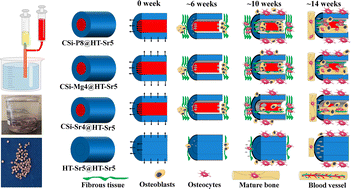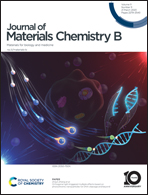Core–shell bioceramic fiber-derived biphasic granules with adjustable core compositions for tuning bone regeneration efficacy
Abstract
Silicate-based biomaterials—clinically applied fillers and promising candidates—can act as a highly biocompatible substrate for osteostimulative osteogenic cell growth in vitro and in vivo. These biomaterials have been proven to exhibit a variety of conventional morphologies in bone repair, including scaffolds, granules, coatings and cement pastes. Herein, we aim to develop a series of novel bioceramic fiber-derived granules with core–shell structures which have a hardystonite (HT) shell layer and changeable core components—that is, the chemical compositions of a core layer can be tuned to include a wide range of silicate candidates (e.g., wollastonite (CSi)) with doping of functional ions (e.g., Mg, P, and Sr). Meanwhile, it is versatile to control the biodegradation and bioactive ion release sufficiently for stimulating new bone growth after implantation. Our method employs rapidly gelling ultralong core–shell CSi@HT fibers derived from different polymer hydrosol-loaded inorganic powder slurries through the coaxially aligned bilayer nozzles, followed by cutting and sintering treatments. It was demonstrated that the nonstoichiometric CSi core component could contribute to faster bio-dissolution and biologically active ion release in tris buffer in vitro. The rabbit femoral bone defect repair experiments in vivo indicated that core–shell bioceramic granules with an 8% P-doped CSi-core could significantly stimulate osteogenic potential favorable for bone repair. It is worth concluding that such a tunable component distribution strategy in fiber-type bioceramic implants may develop new-generation composite biomaterials endowed with time-dependent biodegradation and high osteostimulative activities for a range of bone repair applications in situ.



 Please wait while we load your content...
Please wait while we load your content...